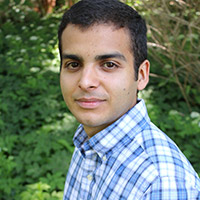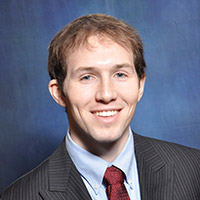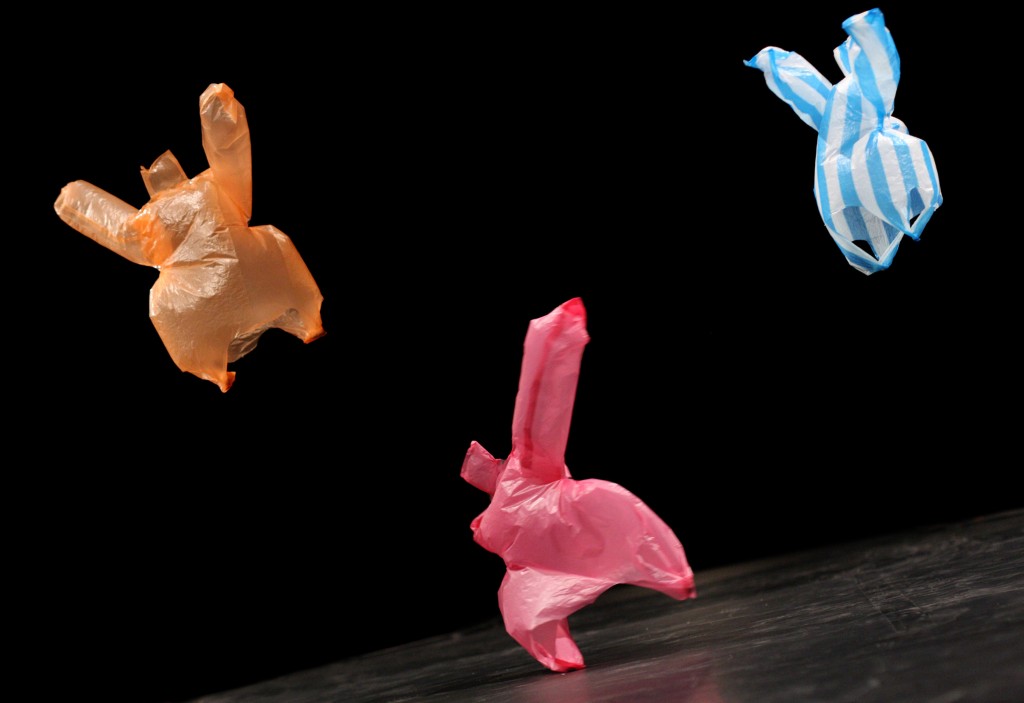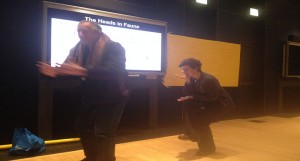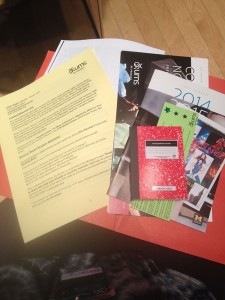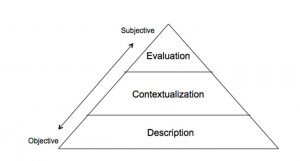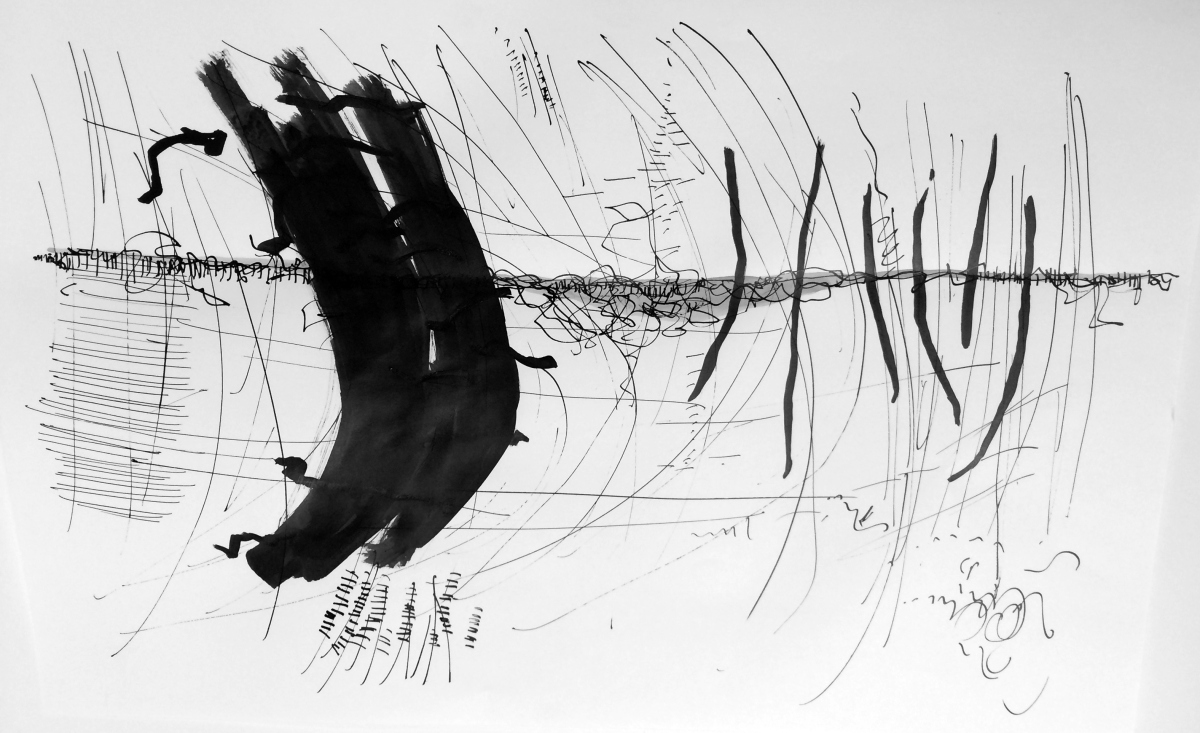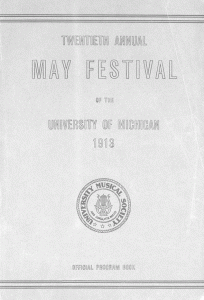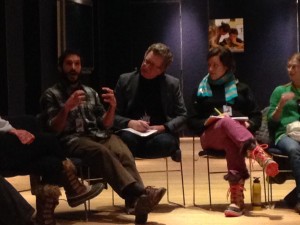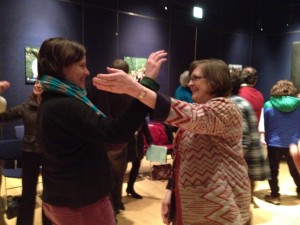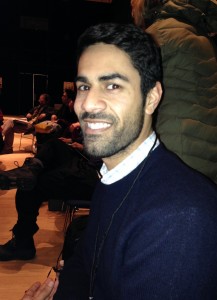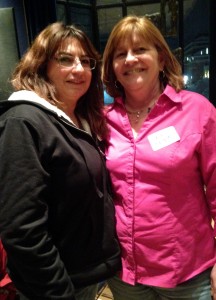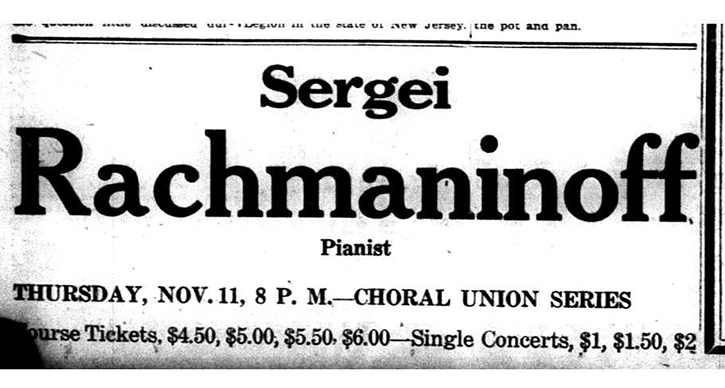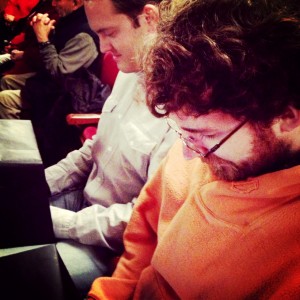On Being African at the University of Michigan

Moment in portrait of myself as my father. Photo by Gennadi Novash.
Nora Chipaumire’s portrait of myself as my father is a piece of many origins. All aspects of Chipaumire’s identity as an African, a woman, a black woman, an African woman, and an African-American woman seep into her work. In this “love letter to black men,” she explores the complex tangle of conceptions, stereotypes, expectations, vulnerabilities and strengths of the black African male.
Zimbabwean influences, unique venue
A dizzying combination of Zimbabwean and African dance traditions, garb, and music help to tackle these big questions. Traditional Zimbabwean music rooted in polyrhythmic beats combines with Zimbabwean dance, an art form which requires a considerable amount of strength and agility to perform. Chipaumire uses these tools to celebrate the strength, resilience, and inherent defiance of the black body. She fuses her Zimbabwean heritage with her contemporary dance training to create this piece. Wearing traditional African gris-gris (a talisman used in Afro-Caribbean cultures for voodoo) with football pads, Chipaumire explores the black male at the crossroads of two cultures and identities.

Nora Chipaumire in portrait of myself as my father. Photo by Elise Fitte Duval.
The piece is set in a boxing ring and will be performed in at the Detroit Boxing Gym, where a program to support kids living in Detroit’s toughest neighborhoods is based and focuses on helping young black males find fruitful after-school activities to grow and develop real-life skills with positive role models.
It is not only a fitting location for Chipaumire’s exploration of black masculinity in a postcolonial world but also serves as a perfect setting for her vigorous, high-energy performance. Chipaumire has also spoken out about the brutal policing of black sexuality and masculinity, and celebrates her heritage through her art.
On Being African at the University of Michigan
African students at the University of Michigan have a unique perspective on the challenges and stereotypes Africans experience in America. Tochukwu Ndukwe, a Nigerian-American kinesiology student born in Nigeria and raised in Detroit, spoke about how his identity as a Nigerian-American student informs his experiences at the University of Michigan. In a school that is overwhelmingly white (a mere 4.4% of the population is Black or African-American), he immediately stands out.
In fourth grade, Ndukwe met a Nigerian student who embraced his culture unapologetically. This student was unafraid to educate other students about why he brought a different kind of lunch to school, or the differences between his how his parents raised him in an African household. Ndukwe was inspired by this classmate, but did not to truly publicly embrace his culture until high school. Torn between wanting to fit in with other black students and wanting to celebrate his culture in public, Ndukwe was both surprised and excited by the strength, unity, and pride of African students at the University. He now serves as president of the African Student Association (ASA), an organization that arranges cultural shows, potlucks, and mixers with other ethnic organizations on campus. Their flagship event is the African Culture Show, a massive celebration of African music and dance that packs the Power Center every year. This year’s show is titled Afrolution: Evolution of African Culture, an inquiry into the future of Africa by African students.
Ndukwe lauds African music as a crucial tether for African students to relate to the culture in their home country. He says that music allows African students to connect with their culture no matter where they are, which is especially important in Ann Arbor, which lacks the music, values, and language of their home countries.
“African music and dance are becoming more and more American,” Tochukwu says. “People there look up to America, they want to be American. African artists are beginning to collaborate with American artists, and I’m like ‘No, don’t lose your culture! It’s so rich!’” Africans are bombarded with American media and feel an increasing pressure to conform music and dance styles to that of American–particularly black American–culture, Ndukwe says.
A very loaded question
We begin discussing gender norms in Nigerian societies (he says many of the Nigerian gender norms are found throughout Africa) and a broad smile spreads across his face. “Oh, boy…you’ve asked me a very loaded question. I don’t even know where to start.”
He says, “African men are expected to be the breadwinners. They’re supposed to be strong, stoic, devoid of vulnerability. They are expected to be the disciplinarian of the family while women are expected to stay home…cook, clean, care for the children.” He explains that the expectation for men to be “macho”, and “hypermasculine” oppresses women, and that the division between genders prohibits women from getting an education and becoming financially independent.
“Mental health hasn’t even begun to be a topic in the general cultural discourse. There’s no such thing as depression, as anxiety for anyone, let alone men. So many men suffer in silence because of it.” As pressures mount for men to be sole breadwinners, disciplinarians, protectors of the family–stoic and strong–many men are subsequently unable to express their emotions with the women they care about. Ndukwe’s background as a Nigerian-born man raised by Nigerian parents tightly bound to their culture informs his relationship with women today. On a personal note, he says that he struggles to express his affection with his significant other. This leads to gaps in communication and rifts in his relationships that are often difficult to repair.
portrait of myself as my father comes at an especially important time. As the consequences of the narrow and stereotypical perception of black men enter the mainstream consciousness, this piece opens the door for discussion.
How does the representation of the black body impact the perception of self as a black woman, an African woman, and an American woman? How has colonialism seeped into the treatment of the black performing body?
Nora Chipaumire asks and investigates these questions in portrait of myself as my father.
See the performance November 17-20, 2016 at the Detroit Boxing Gym in Detroit.
UMS Artists in “Residence”: Spring 2015 Update!
In fall 2014, UMS launched a new Artist in “Residence” program. Five local artists were chosen to take “residence” at our performances. It’s been a pleasure getting to know this cohort throughout the year and exciting to see how UMS performances have helped inspire new works!
Curious what they’ve been up to? Check out the AiR update below, and come chat with the artists in residence in person at our 2015-2016 Season Launch Party on Friday, April 24, 2015 from 5-7:30 pm in Ann Arbor’s Rackham Graduate Building.
Our Artists in Residence have been busy. Have you heard the news?!
Playwright, actor, director, and teaching artist Emilio Rodriguez is co-producing the Metro Detroit Fringe Festival in late June. His play “Swimming While Drowning” will have a reading at the Activate Midwest festival at Western Michigan University in June and also by the Latino/a Theatre Commons in Chicago in July.
Writer Robert James Russell just released his chapbook of short stories Don’t Ask Me to Spell It Out. His next book, a Western called Mesilla —is due out this fall.
Additionally, Russell will be joining the New Harmony Writers Workshop as a Fellow this June at the University of Southern Indiana. He is also honored to be leading two writing workshops in May and June at the Great Lakes Commonwealth of Letters (GLCL) in Grand Rapids.
Pianist Nicholas Gable is thrilled to announce a tentative chamber music performance list: (dates TBA)
César Franck’s Violin Sonata in A Major
Sergei Rachmaninoff’s G Minor Trio (Elégiaque)
Rachmaninoff’s Cello Sonata in G Minor
Painter, drawer, and sculpturist Carolyn Reed Barritt’s artwork was chosen to be reproduced on vinyl and installed on a traffic box downtown Ann Arbor as part of Ann Arbor’s Power Art! public art exhibition. Additionally, three paintings from her Lost Empire series were purchased by Ruth’s Chris Steak House for display in their new Ann Arbor restaurant. Barritt is currently working on a new series of sculptures which she’s very excited about.
Many thanks to our Artists for a wonderful inaugural AiR program. Catch them at the UMS 2015-2016 Season Launch party on Friday, April 24th!
Kyle Abraham’s Childhood Road Trips
Listen to a funny outtake of Kyle talking about childhood road trips to Detroit & Jerry Curls. Check out his upcoming performances on March 13th and 14th: http://bit.ly/1iinyG7
Resident Update: Artist Carolyn Reed Barritt on Compagnie Non Nova
Painter Carolyn Reed Barritt is a UMS Artist in Residence this season. We’ve asked five artists from across disciplines to take “residence” at our performances and to share the work these performances inspire.
Carolyn attended Compagnie Non Nova‘s performance of Afternoon of a Foehn this past weekend at Skyline High School’s black box theatre. She shares her thoughts on the performance:
“I didn’t think I could be so enraptured by ordinary plastic bags…The performance is mastered chaos — each fan controlled to create an airflow which allows the bag puppets to twirl, float and wrestle with each other and their creator in a confined space. Sometimes the puppets skate together along the floor; sometimes it seems as though they are tying to escape by floating up to the ceiling. Sometimes they seem to attack each other. Their creator moves with them, allowing them to dance and fight until they turn on him, using the wind that animates them to envelope and smother him with their bodies, making him so angry he destroys them all. The audio track ebbs and flows from sublime to sinister, the bag puppets go from charming to vindictive, the single, silent actor, ghost-like and imperious — all this in a home-made wind vortex.
If you’re lucky enough to be in Ann Arbor Michigan right now, there are more shows this coming weekend (February 19 – 21, 2015). Otherwise I hope this show comes to you someday!”
Read the full post on Carolyn’s blog
Interested in learning more? Read our interview with Carolyn.
UMS Night School: Curious About Dance – Session 1 Recap
Editor’s note: This post is a part of a series by U-M student and UMS intern Hillary Kooistra, who’s covering our free UMS Night School: Curious About Dance workshop series.
Not New, But In a New Way
If one thing was made clear from Monday’s first session of Night School (besides the fact that Clare Croft calls “intermission” “half time” like in basketball games), it’s that there are tons of awesome dance performances happening in Ann Arbor this winter. Between intimate experimental works, large-scale productions, films screenings, and more, we’ll have plenty to discuss in our Night School sessions each week. As a senior Dance Major at U-M and an avid fan of performances that push the boundaries of how we interpret movement and storytelling, I am definitely looking forward to unfolding this Night School series with a new cohort of dance enthusiasts. I’ve only experienced an hour and a half of Night School so far, but I can tell I’m going to have a great time, especially knowing that each session will be led by two wonderful members of the U-M Department of Dance: Professor Clare Croft and first-year MFA candidate Charles Gushue.
Curious about dance, and all ready for Night School!
We began tonight’s session with a crash course in watching and writing about dance. Clare, a longtime dance critic and writer (who just celebrated the publication of her new book!) showed us some examples of writing that successfully paints a picture of movement on stage. We then engaged in our own writing exercise: we watched four fellow classmates embody aliens exploring the planet and came up with our own descriptive sentences based on the detailed notes we took during their performance.
We observed these four Night School participants and came up with sentences to describe their movement and interactions with the space. It definitely wasn’t too difficult to come up with colorful metaphors, given these vivid characters and images!
Writing about dance begins with observation, and requires awareness and acknowledgement of what it is that we notice. As we observed these “tasty little animals moving through the jungle” (as described by one Night School student), Clare prompted us to take note of details such as how the performers interacted with objects in the space, how they directed their focus, which body parts they maneuvered.
The three major elements of successful dance writing.
After we landed on some descriptions that envied the writing of Deborah Jowitt, Charles launched into a set of activities that prepared us for this weekend’s performance: Afternoon of a Foehn, presented by Compagnie Non Nova. This experimental work is set to Claude Debussy’s Prelude to the Afternoon of a Faun, which also serves as the musical score for the Vaslav Nijinsky ballet L’après-midi d’un faune (The Afternoon of a Faun). Charles shared his experiences dancing Nijinsky’s Faun, and introduced labanotation as a way of seeing how the ballet choreographer recorded his movement on paper.
Night School students Harvey and Linda try out one another’s movement via labanotation.
We experimented (and jovially struggled!) with our own versions of labanotation, then got a taste of Compagnie Non Nova’s interpretation of the Debussy score through plastic bags, which serve as the main playing characters for the production. As we tossed these bags around the circle like a group of slap happy children on the playground, Charles invited us to call out words that described our actions–returning to Clare’s earlier point about how we can use words to describe the movement and interactions we notice. This is what I love about the versatility of the Night School series: in one session, we can regard the movement of the Trisha Brown Dance Company and flitting plastic bags as equally legitimate agents for describing and discussing dance.
Having fun exploring the motions of plastic bags in preparation for Compagnie Non Nova!
Next week, we’ll kick things off with a reflection of Compagnie Non Nova, then begin to prepare for the next set of performances. We will be joined by U-M Associate Professor of Dance Amy Chavasse, who will introduce us to work of the Trisha Brown Dance Company (performances at Power Center Saturday, 2/21 and Sunday, 2/22); and solo contemporary artist and performer Anna Martine Whitehead, who will appear in the U-M Department of Dance performance of Confetti Sunrise (Wednesday, 2/18 and Thursday, 2/19 at the U-M Duderstadt Center Video Studio). These productions, Afternoon of a Foehn included, will each offer us new ideas about how to view and interpret performance, and I can’t wait to see what discussions surface in next week’s session!
Performances this weekend: Compagnie Non Nova, Afternoon of a Foehn, Feb. 14-21, various times, Skyline High School. TICKET REQUIRED.
Session 1 Resources and Readings:
Dancers as Diplomats by Clare Croft
Introduction
Chapter 2
Resident Update: Writer Robert James Russell
Writer Robert James Russell is a UMS Artist in Residence this season. We’ve asked five artists from across disciplines to take “residence” at our performances and to share the work these performances inspire. Robert shares his experiences on dance, music, and his new novel below:
“When I applied for the UMS Artists-in-Residency program, my goal was to see performances and use that inspiration to craft a new novel. I’m beyond thrilled at the chance to experience wonderful performances and explore the role of music and dance in my work—both of which have always been crucial to my mental health, and to my ability to immerse myself in a project.
So far, I’ve seen the following UMS performances, all radically different from one another—and each has inspired me in vastly different ways:
- Ryoji Ikeda (superposition)
- Mariinsky Orchestra
- Compagnie Marie Chouinard
- eighth blackbird
See, this isn’t just writing a novel, coming up with a story and characters, but in this instance I am creating an entirely new place: a fictional island in Lake Superior, documenting the entire history of the island, of the people that lived (and, in the present of my novel, still live) there. Typically when I write I find some style of music that works for that story and I listen to the same record(s) over and over as I write, never growing tire of the repetition. In this instance, though, since it’s not just story, but history…and this immersion in different types of performances has been utterly liberating:
- superposition taught me, even through the wondrous noise, about the use of silence in my work.
- The Mariinsky Orchestra inspired me to embrace more bombastic/dramatic sections of the story.
- Watching the Compagnie Marie Chouinard showed me how to re-think interactions of characters, how they meet in the story, but also how these characters interact with the island itself.
- eighth blackbird encouraged me to embrace the unexpected—to travel different routes in the storytelling, in the creation of the island’s history, of its inhabitants, and to avoid the predictable…to really dig deep and do something unique.
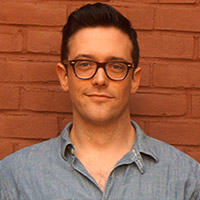 Each of these performances has taught me re-think what I know about art and inspiration, and they are with me every day when I write. In addition to a seemingly never-ending list of books I flip through daily—various back-issues of National Geographic featuring articles about Isle Royale (used as inspiration); a 1937 manual called Wolf and Coyote Trapping; the unbelievably inspiring/gorgeous Atlas of Remote Islands by Judith Schalansky; others—I am constantly harkening back to each performance, remembering them, and making sure that they are not forgotten. And I am reminded with every word I put down how astonishing and remarkable the performing arts are…how important they are to the production of any art.”
Each of these performances has taught me re-think what I know about art and inspiration, and they are with me every day when I write. In addition to a seemingly never-ending list of books I flip through daily—various back-issues of National Geographic featuring articles about Isle Royale (used as inspiration); a 1937 manual called Wolf and Coyote Trapping; the unbelievably inspiring/gorgeous Atlas of Remote Islands by Judith Schalansky; others—I am constantly harkening back to each performance, remembering them, and making sure that they are not forgotten. And I am reminded with every word I put down how astonishing and remarkable the performing arts are…how important they are to the production of any art.”
——
Robert James Russell is the author of two upcoming books: the collection Don’t Ask Me to Spell It Out (WhiskeyPaper Press, 2015) and the novel Mesilla (Dock Street Press, 2015). His first novel, Sea of Trees, was published in 2012. He is the founding editor of the literary journals Midwestern Gothic and CHEAP POP. You can find him online at robertjamesrussell.com and @robhollywood.”
Interested in learning more? Read our interview with Robert.
Resident Update: Painter Carolyn Reed Barritt on Compagnie Marie Chouinard + Mariinsky Orchestra
Painter Carolyn Reed Barritt is a UMS Artist in Residence this season. We’ve asked five artists from across disciplines to take “residence” at our performances and to share the work these performances inspire.
Carolyn attended Compagnie Marie Chouinard on January 23rd, and Mariinsky Orchestra on January 25th, 2015. She shares her thoughts on both performances:
“M
arie Chouinard’s Gymnopedies begins languidly, with the dancers emerging nymph-like and naked from canvas pods, then morphs into a seemingly non-stop riot of movement and role playing that was sometimes so sexy it was almost uncomfortable and sometimes so childishly silly that the audience didn’t quite know whether or not to laugh. The Henri Michaux piece brought movement up to another hyper level and was reminiscent of a dance contest gone too far. The dancers, mimicking the projected ink blots of Michaux’s Mouvements, expressed the drawings in broken, jagged lines, with an awkward jerkiness that was softened with a fluid, serpentine beauty.”
On Mariinksy:
“Before entering the hall for Mariinsky, I was given a flyer by a person protesting the orchestra. Last weekend I read the New York Times’ interview with Gergiev. I know a little about the situation in Ukraine, but don’t know as much as I should. Reading neither the flyer or the Times interview really enlightened me as to Gergiev’s personal views or the views of anyone in the orchestra. But what I have heard and read about Ukraine was in my mind at the concert and I’m sure it tainted my experience that afternoon.”
Read the full post on Carolyn’s blog
Interested in learning more? Read our interview with Carolyn.
UMS Choral Union Sings Ken Fischer Happy Birthday!
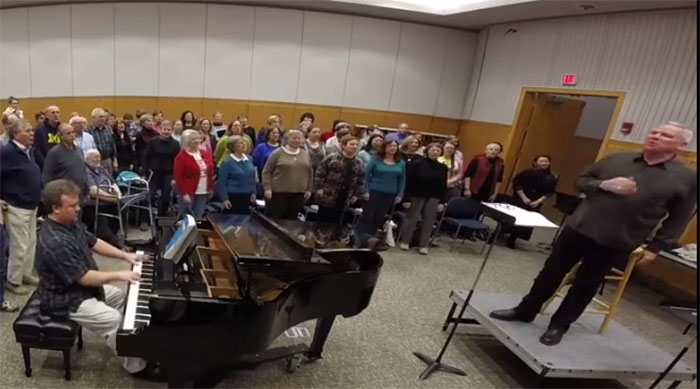
The Choral Union wished Ken Fischer, the UMS President, a Happy 70th Birthday last week! Watch the video here.
This Day in UMS: Twentieth Annual UMS May Festival
Editor’s Note: “This day in UMS History” is an occasional series of vignettes drawn from UMS’s historical archive. If you have a personal story or particular memory from attending the performance featured here, we’d love to hear from you in the comments.
May 14-17, 1913: Twentieth Annual UMS May Festival
Featuring five concerts over five evenings, the Chicago Symphony Orchestra, UMS Choral Union, and the Children’s Choir were featured on the Twentieth Annual May Festival, the opening series of concerts at Hill Auditorium. The opening concert featured works by Wagner, Beethoven, A.A. Stanley, and Brahms.
Hill Auditorium celebrated its one hundredth birthday on May 14, 2013. If you’d like to learn more about our history with the storied venue, watch our documentary A Space for Music, A Seat for Everyone.
UMS Night School: Bodies in Motion – Session 4 Recap
Editor’s note: This post is a part of a series of by U-M student Sarah Squillante, who’s covering our free UMS Night School: Bodies in Motion series. Learn along side with them.
Does a discussion of theatre belong in a Night School series devoted to dance? Is there a place for opera, on-stage violence, even music? After Monday’s UMS Night School session, most attendees would probably say that it does.
Host Clare Croft reminded attendees that there are multiple ways to enter a performance. Even in theatre, she said, it’s useful to pay attention to movement and ask ourselves: How are performers using the space? What can we learn about the characters from how they move or stand? She introduced four speakers who offered their personal take on the upcoming performance of Théâtre des Bouffes du Nord’s production of The Suit, directed by Peter Brook.
Naomi Andre, U-M Associate Professor of Women’s Studies, explained the significance of South African opera, reminding participants of dance-like qualities of voice performance. UMS Campus Engagement Specialist, Shannon Fitzsimons, spoke about legendary theatrical director Peter Brook, and touched on his “sense of visual economy” and “commitment to emotional truth,” among other details. UMS Director of Programming, Michael Kondziolka, touched on his skepticism before seeing the performance for the first time and his reasons for selecting the piece. He noted that it is really “telling a story about the movement of bodies.” Finally, Rob Najarian, U-M Assistant Professor of Theatre and former fight/violence director, encouraged attendees to think about the “shared experience” between audience and performer. He led a movement exercise that illustrated the deliberate nature of movement.
Attendees also had a chance to reflect on the past weekend’s performances of Compagnie Kafig, demonstrating a movement that embodied the show to share with the group; many found that the troupe had an incredible amount of athleticism and humor.
One attendee noted that her experience at the You Can Dance workshop affected her viewing of Compagnie Käfig: “It wasn’t the type of move that makes you go to your friends and say, ‘wow did you see that?’ but I really noticed the intricacy and complexity in movements that seem so simple,” U-M graduate and frequent Night School attendee Sasha Kapshai said.
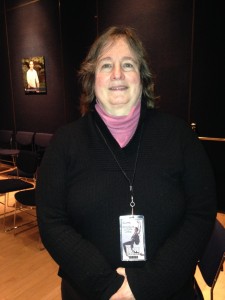
Attendee Jane Michener didn’t have plans to see The Suit before the evening, but then changed her mind. “I’m intrigued by all the intricacies of how it’s put together,” she said.
Session 5 of Night School, Body Experiments, will explore ways in which dancers experiment and create new ideas in dance, preparation for Jennifer Monson and DD Dorvillier’s RMW(a)/RMW, and discussion of The Suit. Special guests include: Anita Gonzalez, U-M Professor of Theatre and Drama, Amy Chavasse, U-M Associate Professor of Dance, Larry La Fountain-Stokes, U-M Associate Professor of American Culture, Gillian Eaton, U-M Assistant Professor of Theatre, and Rob Najarian, U-M Assistant Professor of Theatre.
The upcoming weekend is full of dance-related viewing opportunities! Check out the Dance on Camera Festival at the University of Michigan Museum of Art and the UMS performance of Théâtre des Bouffes du Nord: The Suit, 2/19-2/22 at the Power Center.
Session 4 Resources
- Excerpt from Peter Brook’s The Open Door
Interested in even more dance engagement? Pick up an adventure card to learn all about the dance activities we’re offering this year and for a chance to win a backstage meet and greet.
For a complete list of 2013-2014 dance performances, visit ums.org. Share questions, comments, or suggestions in the comments below.
UMS Night School: Bodies in Motion – Session 3 Recap
Editor’s note: This post is a part of a series of by U-M student Sarah Squillante, who’s covering our free UMS Night School: Bodies in Motion series. Learn along side with them.
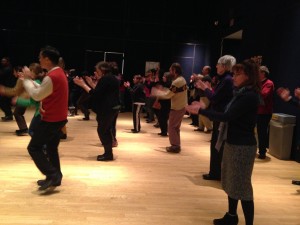
UMS Night School attendees danced to a new beat this week – literally. Midway through the session, attendees were asked to get up on their feet, learn a basic Capoeira step, and then free-style in a large circle to funk music. The movement exercise, led by U-M Dance MFA Candidate Marcus Whiten, gave attendees a kinesthetic taste of a distinct style – a mix of hip hop, martial arts, and acrobatics – that Compagnie Käfig will bring to Ann Arbor this weekend, February 14 and 15.
This week also marked the beginning of a new format in which attendees have the opportunity to discuss a recent dance performance. This week’s discussion centered around “Moving Pictures,” a concert featuring 4 works performed by the U-M department of Dance. In a short panel discussion, three dancers spoke first of the larger ideas that they were asked to conceptualize during the beginning stages of the pieces, then progressed to more specific elements of the performance, like costuming and live music. The dancers expressed delight in the challenges that the pieces provided and in the connections that they were able to make with the audience.
The attendees comprised a diverse a group as usual, ranging from experienced dancers to those who had never seen a performance before. The class has grown significantly since the first week. Some have become Night School “regulars,” while others ventured out into the cold for the first time.
In the left photo, newcomer Razi Jafri said he came because he “didn’t really know anything about dance – artistically or technically,” so he figured it’d be a good introduction.
On the right, Lucie Cohen and Deb Taylor came to Night School thinking they’d be seeing a dance performance, but were pleasantly surprised by the discussion format. “I really enjoyed getting involved when we started moving. The proximity of our bodies made me feel like I knew people on a personal level,” Lucia said.
Leslie Woldenberg, a dance lover and frequent UMS patron, drove all the way from Toledo with a friend to experience Night School for the first time.
The session finished with a short talk from Reighan Gillam, Postdoctoral research fellow in the U-M Department of Afroamerican and African Studies, who spoke about the origins of hip-hop music and dance in Brazil. Gillam emphasized the fact that rappers come from the periphery of Brazil and that, much like hip hop in the United States, the content typically revolves around the violence and system inequality characteristic of marginalized groups.
The details – and the questions they inspired – were intended to help attendees frame their viewing of Compagnie Käfig. Night School host Clare Croft suggested that attendees use information from the lecture to consider how the atmosphere in Brazil may impact the movement they see on stage.
The fourth session of Night School will include an exploration of how actors think about movement, with a preparation for Théâtre des Bouffes du Nord’s The Suit, and also a discussion of Compagnie Käfig’s Correria Agwa. Special guests will include: Naomi Andre, U-M Associate Professor of Women’s Studies, Rob Najarian, U-M Assistant Professor of Theatre, and Michael Kondziolka, UMS Director of Programming. It will be held at the U-M Alumni Center at 200 Fletcher Street at 7 PM.
Session 3 Resources & Readings
- UMS Learning Guide on Compagnie Käfig
- Performance prep reading on Capoeira – “Headspin” by Barbara Browning
- Bodies in Motion Session 3 – Key Themes, Players, and Definitions [Word Document assembled by Marcus White, MFA Candidate – Dance, University of Michigan]
- Session 4 Prep Reading: Excerpt from Peter Brook’s The Open Door
Interested in even more dance engagement? Pick up an adventure card to learn all about the dance activities we’re offering this year and for a chance to win a backstage meet and greet.
For a complete list of 2013-2014 dance performances, visit ums.org. Share questions, comments, or suggestions in the comments below.
UMS Night School: Bodies in Motion – Session 1 Recap
Editor’s note: This post is a part of a series of by U-M student Sarah Squillante, who’s covering our free UMS Night School: Bodies in Motion series. Learn along side with them.
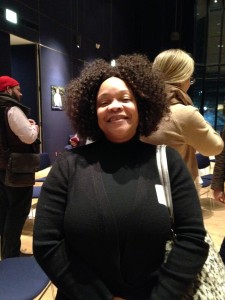
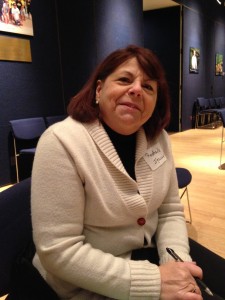
Lisa Beard (Left) and Rochelle Igrison (Right) are both enthusiastic to expand their dance knowledge.
UMS Night School isn’t designed to be a dance class, but the first session got people moving just enough to start to think differently about movement. Community members of all ages and backgrounds stood in a semi-circle in the chilly University of Michigan Alumni Center on Monday night, introducing themselves not just with names but an accompanying gestures.
Clare Croft, assistant professor of dance at the University of Michigan who’ll lead Night School this season, asked what the exercise made everyone think of and what images came to mind when they heard the word “dance.”
One attendee noticed that when the participants were asked to omit their names from the introduction, the gestures were a lot easier to understand and remember, and another suggested that movements can “characterize people and carry meaning.”
Jim Leija, director of education and community engagement with UMS, welcomed participants and said that Night School is an opportunity to “improve our comfort level with dance and make room for a reflective moment.” He emphasized that the program would not be a lecture series, but rather an interactive experience. The first session didn’t disappoint. Participants stretched out their arms in various ways and explored the ways in which even simple movement – like rubbing hands together – can be executed in many ways. Many were eager to suggest topics that they hoped to address in the coming weeks, like why we prefer certain performances over others and how dance evokes political messages.
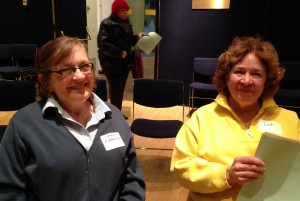
Pat Bantle (Right) is a return night-school student. “I love dance,” she said. “I came last year and I enjoyed it very much.”
Some of the participants seemed excited to engage with a medium that they already love. Lisa Beard drove all the way from Oak Park to participate. “I just turned 50 and I promised myself I’d do things I’d never done before,” she said. A longtime patron of the arts, Beard is excited to meet new people. Rochelle Igrison explained that she’s been to all of the UMS dance performances thus far. “I may not have a dancer’s body, but I can still be a patron of the arts,” she said. “I just love dance.”
Others were more explicit in what they hoped Night School would do for their engagement with the arts. Art, a frequent UMS concert goer, said he was eager to expand his dance vocabulary in order to engage in conversations after performances. “I want to be able to talk about it,” he said.
Croft showed a series of videos that touched on a breadth of dance styles and considerations, from Martha Graham’s Lamentations to a video from the 2008 Beijing Olympics. She suggested, in her parting thoughts, that participants use the sessions not only to “define what dance is, but what it does.”
Next week’s Night School, “Moving Pictures,” will welcome a U-M professor of Movement Science and a professor of Art and Design. It will again be held at the U-M Alumni Center at 200 Fletcher Street. Interested in even more dance engagement? Pick up an adventure card to learn all about the dance activities we’re offering this year and for a chance to win a backstage meet and greet!
Download Sesssion 1 Resources, including key concepts, videos, and vocabulary from the first session [Word Document assembled by Marcus White, MFA Candidate – Dance, University of Michigan]: Bodies in Motion Session 1 Key Themes, Players, and Definitions
For a complete list of 2013-2014 dance performances, visit ums.org. Share questions, comments, or suggestions in the comments below.
Interviews with Uncommon Virtuosos: Robert Alexander
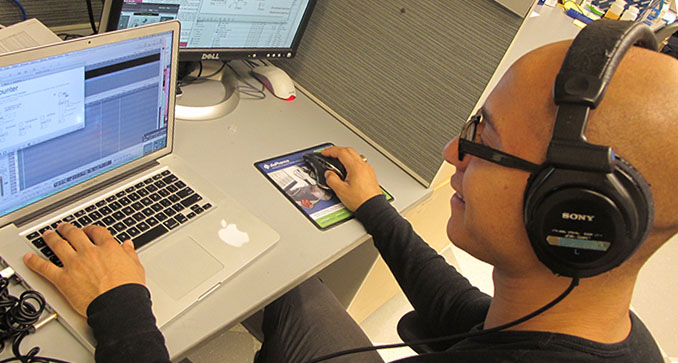
Photo: Robert Alexander. Photo by Kärt Tomberg.
Robert Alexander is a sonification specialist working with the Solar and Heliospheric Research Group at the University of Michigan, where he is pursuing a PhD in Design Science. He is also collaborating with scientists at NASA Goddard, and using sonification to investigate the sun and the solar winds.
We met Robert this fall and got to talking about “uncommon virtuosos” – those who master an instrument or genre in unexpected ways, whether Colin Stetson on the baritone saxophone this January or Chris Thile on the mandolin last October.
We sat down with Robert to talk to him about the nuts and bolts of sonification, his new work in sonifying solar wind and DNA, and whether he’d consider the sounds of the sun improvisation.
Nisreen Salka: How did you get into sonification?
Robert Alexander: My background is in music composition and interface design as the focus of my undergraduate and master’s studies, and I transitioned more into using those disciplines towards scientific investigations more recently. I came to work with sonification specifically when I was approached by Thomas Zurbuchen, who is the leader of Solar Heliospheric Research Group (SHRG), and they had this crazy idea of hey, let’s take our data, turn it into sound, and see if we can learn anything new.
NS: Could you describe sonification for the laymen among us? How does that relate to your previous experience in music composition?
RA: Sonification is the use of non-speech audio to convey information. And the idea is that rather than visualizing data and creating a graph or something of that nature, we can instead create an auditory graph. So if we have something like a data value that’s constantly rising, rather than displaying that as a line that constantly goes up, we can have a sound that constantly goes up in pitch.
NS: In your mini documentary about the project with Solar and Heliospheric Research Group (SHRG), you talk about including a drum beat and an alto voice to better personify the satellite data. How did you figure out which musical elements would work?
RA: Well, it’s a process where I first begin by getting as close to the data and the underlying science as possible because I want to let the data to speak for itself, and try to find the natural voice of the data. Once I get a sense for what the data are actually saying and what the data parameters are actually telling me, then I can start to think a little bit about, okay, how could this unfold musically?
And that’s largely a process of trying to work with informed intuition. I’m trying to think about what sort of knowledge the listener is going to bring to the listening process, and I try to work with sounds that might be intuitive.
NS: Sonification seems like a medium for improvisation, but there’s a lot of structural overlay. Do you, as a composer, consider your work improvisational?
RA: I think there’s very much an improvisational element, and you’re going to find that in scientific research even though you may expect it less. We’re talking about an interaction in which we feel so connected with our instruments that we are able to go from an idea to an expression of that idea in a very short amount of time. And one of my goals has been to take this kind of immediacy and try to infuse the sciences with that immediate feedback.
NS: It sounds like sonification really a combination of two disciplines. How did this fusion happen for you? What about this process attracts you both as a scientist and an artist?
RA: As a composer, I’ve always used music to explore my own psyche and the human condition as a form of self-expression. I think the largest shift that took place in my thinking as a composer was this kind of shift from thinking about music and asking, “What do I want to express?” to instead thinking, “How could I use these compositional tools to allow something like the sun to express itself?” I saw this as an opportunity to take something I really love and channel that through a rich learning process.
When science or music happen at a very high level, they are both infused with creativity. And I think the idea of that separation between art and science is more of a modern invention. When I think about these two disciplines, I tend to think about the things that bring them together. A lot of science has sprung forward through different types of intuitive leaps, and I think that it’s this place of intuition that plays into the process of being a creative professional or of being a scientific researcher. That’s the core of a lot of the work that I do.
NS: How do you think people receive what you do? What is their perception when they see the final result?
RA: I think many people initially think, well that is “cool.” But for me, the question isn’t, “How do we make something cool?” The question is “How do we learn something new?” In the moment when we are able to uncover something in a data set with our ears, it’s still cool. But to actually learn something, then it also becomes powerful.
In all of my work, I try to pair the music and the data such that I’m providing knowledge as to how the musical form is drawn directly from the underlying data set. I like to encourage the listener then to simultaneously absorb the music and to investigate the underlying science because that’s when sonification really becomes powerful, when it can fuel the learning process. It takes the abstract and the esoteric and makes it more approachable.
NS: We know that one of your newer projects is the sonification of DNA. How does that relate to your previous work? What about it is new and what about it is similar to what you have done in the past?
RA: This project was an opportunity to take everything I have learned in the space sciences and to apply that to a new discipline in which I had limited prior knowledge. Just like working with solar wind data, we were working with incredibly large amounts of information. Millions of data points could potentially be passing by the ear over the course of a minute.
We were successful in creating an auditory translation, where you can hear where the transcription process starts and ends, and you can hear the structure of the gene. It was really fascinating to have a sense for how this would unfold temporally rather than just seeing it as a sequence of numbers or letters.
A lot of genetic research has also utilized spectral analysis to analyze repeated elements in DNA. And turns out if we take that raw data and turn it into sound, we can hear those repeated elements. Sonification could potentially allow us to hear some of the subtle details in these structures.
NS: Is there anything else we haven’t covered that you want to add about your projects?
RA: There are still a lot of mysteries when it comes to solar science. And we are looking at sonification as a way to gain new insights. Working at NASA Goddard alongside several research scientists there, we actually uncovered quite a variety of new features with our ears that we’re now investigating through traditional research methods.
And so for me, it’s a really exciting time. We came into the project wondering if we’d find something new, and now we’re at the point where I can say that we have been successful in uncovering new science through the process of data sonification, and we’re continuing to discover new things.
Learn more about Robert’s work here. Questions or thoughts? Leave them in the comments below.
This Day in UMS: Sergei Rachmaninoff
Editor’s Note: “This day in UMS History” is an occasional series of vignettes drawn from UMS’s historical archive. If you have a personal story or particular memory from attending the performance featured here, we’d love to hear from you in the comments.
November 11, 1920: Sergei Rachmaninoff in UMS Choral Union Series
Photo: Advertisement in the Ann Arbor News (Ann Arbor News Ann Archives, Arbor District Library).
The celebrated Russian pianist and composer Sergei Rachmaninoff performed solo in Hill Auditorium as part of the 42nd season of the Choral Union Series on November 11, 1920. He opened his recital with a performance of “The Star Spangled Banner,” during which the entire audience remained sanding. The remainder of his program consisted of six pieces: Beethoven’s Sonate Opus 90 in e minor, Mendelssohn’s Six Songs Without Words, Chopin’s Ballade, Valse, and Barcarolle, Grieg’s On the Mountains, Liszt’s Rhapsodie Espagnol, and his own Prelude, C-sharp minor Etude-Tableaux, Opus 33.
His masterful tone, unique personality, and flawless technique delighted a sold out Hill Auditorium, as audience members were in awe of his interpretation of his own works and how he portrayed the sorrow and fatalism of his own Russia. Sergei Rachmaninoff returned to Ann Arbor and Hill Auditorium for a second time in 1939, performing another solo recital as part of the 61st Choral Union Series.
UMS Student Committee Learns to Kazoo
UMS Kazoo Orchestra director Garrett Schumann teachers our student committee how to kazoo. Learn more about our kazoo orchestra, or join the fun.
Tweet Seats: Mariachi Vargas de Tecalitlán
For our second tweet seats event, we saw Mariachi Vargas de Tecalitlán in Hill Auditorium
Meet the participants.
UMS: Tell us a little about you. If you have an online presence you like to share publicly, please tell us the relevant websites or user names/handles.
Matt Landry: I am a K-12 certified music teacher, a University of Michigan graduate, Detroit Symphony Orchestra intern, and saxophonist of the Akropolis Reed Quintet, a five-time national prize-winning classical music ensemble. I tweet from @akropolis5tet, and I help manage the ensemble’s website: www.akropolisquintet.com.
Jared Rawlings: I am a process-centered innovative teacher, and an emerging researcher. I tweet @Jared_Rawlings and my website is: www.jaredrawlings.com.
UMS: In one sentence, how would you describe your relationship with technology?
Matt Landry: I have a love/hate relationship with technology, enjoying its contribution to bettering life while wondering if it is making humans less human.
Jared Rawlings: My relationship with technology is necessary in order to build my personal/professional learning network.
UMS: Why did you decide to participate in this project?
Matt Landry: I decided to participate in order to further deepen this relationship. I wonder if being engaged electronically in a live performance will enhance or detract from the beauty on stage.
Jared Rawlings: I am always looking for new ways to include professional development – on demand.
UMS: To you, what does it mean to “be present” during a performance or another arts experience?
Matt Landry: To be “present” at a performance one must consider what the event will be remembered as. One must comprehend the magnitude of the live performance, clear the mind to listen and/or view, and have a perspective of the event while it is occurring. Looking back on events and their personal significance is important, but doing so at the time of the performance, to me, is being “present.”
Jared Rawlings: Being present means it’s a way of capturing the “lived experience” of the concert goer. Also, given the temporal nature of music, theatre, and dance the tweet seats project is a way of focusing in on this phenomenon that is exclusive to live arts in Ann Arbor.
Meet the tweets.
UMS: How did tweeting affect your experience of the performance; did you expect this effect or are you surprised by this outcome?
Matt Landry:
Jared Rawlings:
Curious about live tweeting during a performance? Sign up.


